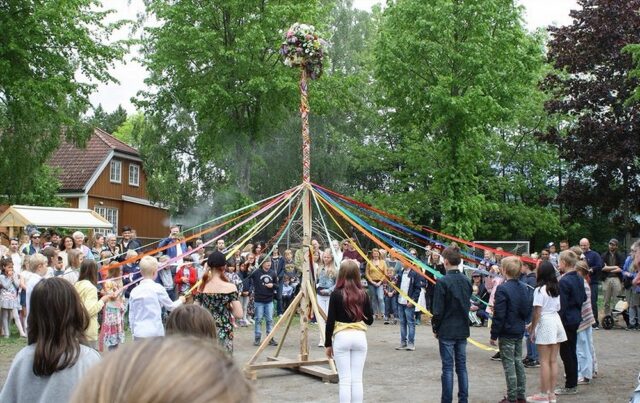
Definition:
A “maypole” is a tall wooden pole, often decorated with ribbons, flowers, and other ornaments, or made to resemble the Christian Cross, that serves as the focal point for traditional May Day and Midsummer celebrations.
Etymology:
The term “maypole” derives from “May,” the month associated with springtime festivals, and “pole,” from the Old English “pāl,” meaning a long, slender, cylindrical object.
Description:
Participants, usually in festive attire, perform dances around the maypole, intertwining the ribbons as they go.
In Sweden, the maypole, known as “midsommarstång” or “majstång,” is a key feature of Midsummer celebrations, which occur around the summer solstice. The pole is often decorated with leaves and flowers, and dancing around it is a communal activity.
In England, maypole dancing is a central part of May Day celebrations on May 1st. Participants dance in intricate patterns, weaving the ribbons around the pole.
In Germany, maypoles, or “Maibäume,” are erected in town squares for May Day celebrations, often accompanied by music, dancing, and folk traditions.
Some communities in the United States of America, particularly those with European heritage, also celebrate with maypoles during May Day or other spring festivals.
Symbolism:
The maypole is a phallic symbol and carries the same symbolism as the stripper pole. The maypole is often topped with flowers, creating the sex symbolism of the lowercase letter “i,” which is a vertical line (penis) pointing towards a dot (often representing a vagina). Some versions of the maypole resembles the Christian Cross.
During the May Day/Midsummer festival on Saint John’s Eve, especially in Sweden, it is traditional for many children and young people to dance circle dances around a maypole. People are told that they do this to celebrate youth and fertility. In other words, it means that it is a disturbing celebration of children reaching sexual maturity. Circling around the maypole is symbolic of go symbolism and SLM symbolism, representing madness and the circulation of the sun and moon. The ribbons circling the maypole resembles a merry-go-round.
